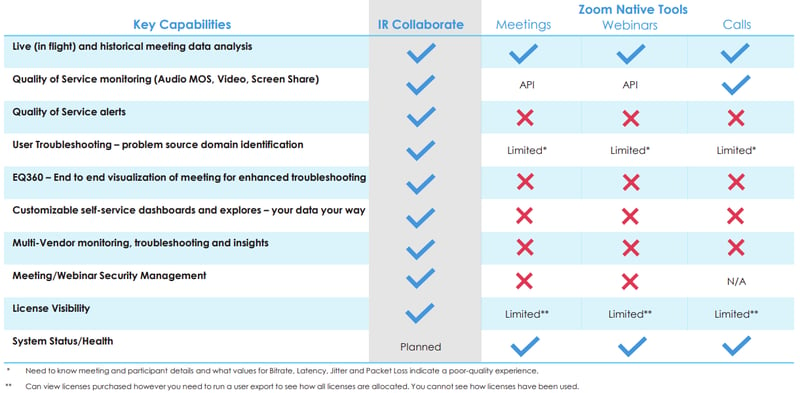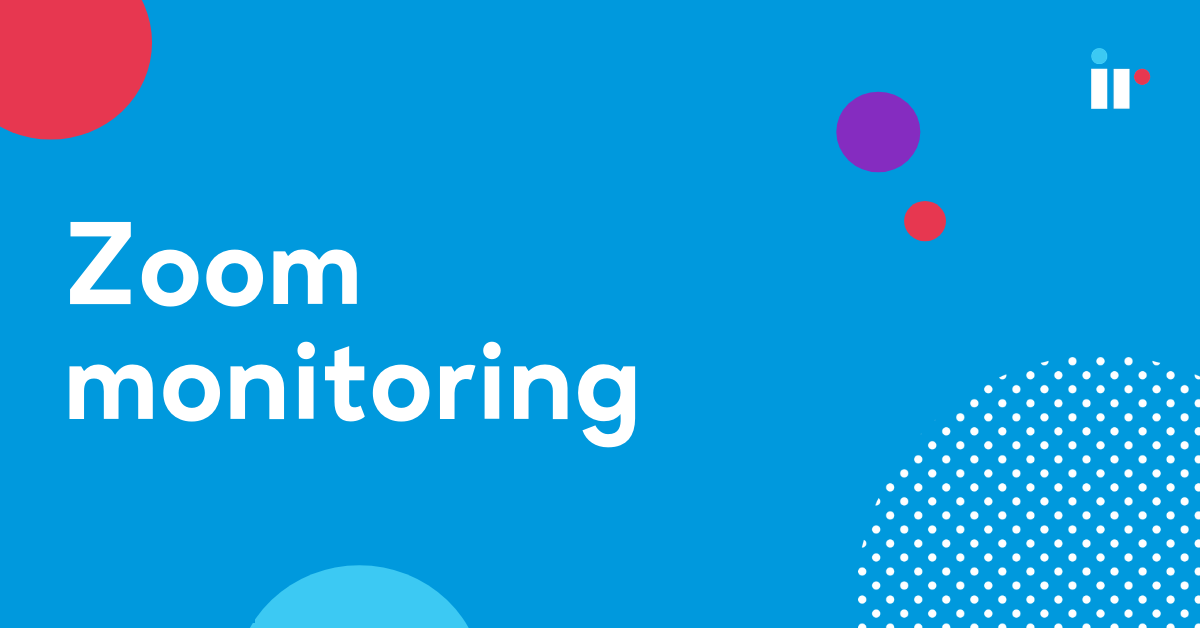There’s no doubt that video meetings enabled by conferencing applications such as the Zoom platform, are enabling business continuity and fueling corporate growth.
Unified Communications and Collaboration Market size exceeded USD 45 billion in 2021 and is poised to register gains at over 10% from 2022 to 2028.

Image source: Global Marketing Insights
Without unified communications, and video conferences in particular, the global workforce would be in complete chaos.
Online meetings have largely replaced face-to-face meetings in the post-COVID working world, and the new hybrid working culture is now very much dependent on video solutions like Zoom, Microsoft Teams, Cisco WebEx, and a huge array of similar players.

Image source: Computerworld
Download a PDF version of our Zoom guide: An essential guide for Zoom Enterprise Deployments [Ensuring Success at Scale]
Monitoring and performance management
But it's not just the video conferencing tools that determine successful unified communications and collaboration. Network performance for example, plays a big part, and things like a poor quality connection can derail a meeting in no time.
In this blog we'll focus on the Zoom platform, and discuss the importance of monitoring and managing your Zoom services to get the best quality performance from the platform.
Zoom and communication
Corporate enterprises, educational institutions, government organizations and the healthcare industry all use video conferencing in the course of their daily operations, and one of the most widely used tools today is Zoom.
Zoom users have grown - and since the pandemic, the Zoom platform has seen usage take off at lightning speed, due in large part to its ease of use, consistent call quality, the ability to host a large number of attendees in meetings - and flexible software configuration options.
But while Zoom is a people-orientated meeting application, when it entered the playing field, it was a relatively new contender at enterprise level.

Image sources: Backlinko
Zoom and performance issues
All video conferencing platforms rely on an internet connection, making them susceptible to network jitter, lags, freezing, or dropping out altogether.
Not only is this frustrating, but it could easily result in a lot of lost time and productivity, which for a large enterprise is not acceptable.
Here are some common problems that affect Zoom's performance:
Endpoint issues
In the physical office, keeping control over the devices and equipment was far less of a challenge for IT teams than it is in today's hybrid working world. Scenarios that can affect performance include:
-
Connecting to Zoom through WiFi rather than a wired connection
-
Users logging in from a variety of locations, via sub-par networks
-
The widespread use of BYOD, which are less likely to be properly configured for lengthy Zoom sessions
-
The Zoom software incorrectly installed
-
Outdated hardware, or equipment compromised by malware
Competition for bandwidth
Network performance is a key issue that depends on how much is being consumed. In a home office environment, bandwidth is usually a limited resource, and the Zoom application can consume quite a bit.
Quality of Service (QoS) refers to the capability of networks to assign and reserve resources for applications or data flows by reducing the amount of available bandwidth that other devices on the network are using. To prioritize Zoom video traffic with Quality of Service, you can enable this on your router.

Image source: Fortinet
Why it's important to monitor Zoom
Successful deployment of any collaboration tool is dependent on continual monitoring of its performance.
If you don't monitor Zoom, there's no way to be able to analyze call usage by end users, or proactively identify and address issues with calls as they occur.
Without visibility into your Zoom video usage, you can't pinpoint the exact cause and location of problems.
In many large enterprises a UC environment consists of a diverse range of collaboration tools. Your organization might use Zoom for collaboration, plus multiple other vendors and apps, as well as a variety of locations and countless remote devices.
Monitoring with a native tool
In today's hybrid UC environment, it's impossible to monitor and manage everything with a native tool. Zoom's out-of-the-box performance management tools won't work in the multi-vendor environment that most enterprises face.
Third party monitoring tools become even more important to capture data related to network performance information, connectivity details, device and identify problems in real time.
Consistent monitoring will also help free up IT teams to concentrate on more important issues, by being proactive and pre-emptive rather than taking reactive measures.
Zoom’s diversity increases the necessity for monitoring
One of the key features of Zoom is its intuitive app integration capability. You can use Zoom Meetings with most of the other top UC apps including Microsoft Teams, and many more.
Zoom Video also has a user-friendly room system, its diversity with multiple operating systems and its ability to scale capacity quickly and easily. Its easy integration with best of breed SaaS apps, from sales and marketing and content management, to security and compliance and SSO make Zoom even more popular.
Some of their most popular integrations include Google Drive, Dropbox, OneDrive, HubSpot, Slack, Gmail, and Office 365.
But with all this convenience and diversity, the chances of achieving a good user experience tend to diminish.
According to research by Nemertes, 54% of organizations are deploying more than one provider for their communication and collaboration needs, in fact, on average, companies use 3.8 providers.
Added to the mix is Zoom’s support of the Bring Your Own Device (BYOD) culture, increasing the number of end users, and in turn the scale of problems. This is why it's vital to monitor.
Zoom monitoring with IR Collaborate
As mentioned, out-of-the-box Zoom administration tools don’t have the capability to drill down as deeply or address the level of proactive insights as a third party tool like the IR Collaborate experience management solution for Zoom.
With a diverse and integrated UC environment, organizations need advanced tracking technology to monitor, measure, and benchmark Zoom phone call quality, security, and consistent network connection.
IR Collaborate, powered by the powerful Prognosis platform, is designed to ensure a consistent, positive user experience with a higher rate of uptime and connectivity status. This results in faster problem resolution and consistent end user satisfaction.

Monitoring for your entire UC environment
IR Collaborate provides monitoring and performance management for not just Zoom but your entire UC environment, and can provide analytics and proactive actionable insights in real time, as well as status notification and alerts.
These are among the key features you won't get from the Zoom native administration experience.
Read our blog Monitoring Zoom: 3rd Party vs native tools
Zoom Monitoring with IR Collaborate provides a better experience
The pressure to deliver a good user experience is always high. But there are many complexities to consider.
Internal network routing can include proxies, security services, central internet bandwidth, backhaul multiprotocol label switching (MPLS) circuits, network address translations, and more. It's a lot to monitor.
Collaborate's Zoom monitoring solution is designed to ensure a consistent, positive user experience and increased satisfaction.
Here are some more of the features of Collaborate's monitoring solution for Zoom.
Real-time intelligence
Customized reporting and dashboards enable real-time insight to help you monitor call quality, measure usage, understand user experience, and resolve problems as they are happening, to improve user satisfaction with your Zoom investment.
End-to-end visibility
With complete visibility across Zoom meetings, calls, rooms and webinars from a single view, as well as automated monitoring and alerting, you can streamline Zoom management and deliver a great user experience, every time.
A better user experience
Streamline Zoom experience management, and ensure user productivity and satisfaction with deep insight into in-flight and historical calls and meetings, as well as endpoint performance data for user and room devices.
Find and fix issues fast
Quickly identify and resolve issues that impact user experience and productivity, with real-time insight, fast troubleshooting and proactive alerting across your Zoom environment.
Pinpointing problems
Monitoring with IR Collaborate can pick anomalies from any point in your network, for example:
-
Is it only one user, or multiple users having issues?
-
What is the root cause of the problem?
-
Is it the internal network?
-
Could it be the user’s home wi-fi?
-
Is the problem related to the user’s laptop?
-
Could it be the VPN?
-
Or is it something to do with Zoom itself?
Zoom Meetings has the capacity to host a great number of attendees, but uses more bandwidth, so you need to monitor to make sure that your UC environment can handle the load.
Monitoring Zoom also ensures smooth deployment by testing your route to the cloud as well as end user experience.
Zoom monitoring can also prevent unexpected issues and delays within the app, as well as spotting any critical service delivery issues before you onboard new users.
Monitoring Zoom: Key takeaways
-
Monitoring tools become even more important when used in the multi-vendor environment that most enterprises face.
-
Monitoring greatly reduces the drain on your IT resources
-
Monitoring Zoom calls is important across multiple user devices in the office and at home, including laptops, smart phones and tablets, desk phones, soft phones, video clients, USB, and audio devices and much more.
-
Without monitoring Zoom service, calls and meeting quality, it's impossible to manage performance.
-
Consistent monitoring creates a secure UC environment that will put your organization on the path to a prosperous digital transformation.
Zoom is so important, not just for meetings and conferences, but to the success of your entire unified communications strategy.
For more on how to ensure the performance of your collaboration tools, find out more about our Collaborate suite of solutions.
Download a PDF version of our Zoom guide: An essential guide for Zoom Enterprise Deployments [Ensuring Success at Scale]





